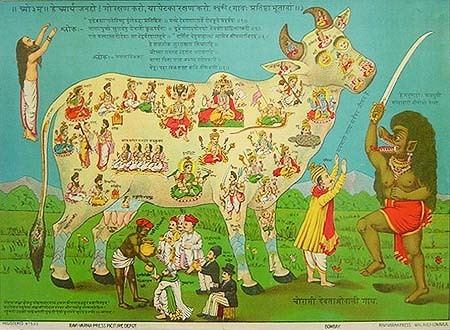Religions Hinduism | ||
 | ||
Languages Marathi, Oriya, Telugu, Kannada, Tamil Populated states Maharashtra, Odisha, Telangana, Andhra Pradesh, Karnataka, Tamil Nadu Subdivisions Gavara & Kalinga Komatis | ||
Arya Vaishya (Arya Vysya) or Komati is an Indian caste. Orthodox Arya Vaishyas follow rituals prescribed in the Vasavi Puranam, a religious text written in the late Middle Ages. Their kuladevata is Vasavi.
Contents
The Arya Vaishya are divided into two sub-sects, the Gavara Komatis and the Kalinga Komatis. The community were formerly known as Komati Chettiars but now prefer to be referred to as Arya Vaishya.
Etymology
The Komatis are said to have originally lived in large numbers along the Godavari River, which the locals called Gomati or Gomti. The Sanskrit Gomati was rendered into Telugu as Komati.
Hanumantha Rao noted that the merchant classes preferred Jainism for gaining social status and respectability, and the erstwhile Banias became Gomati or followers of the Gomata cult in medieval times. The story of Vasavi, the caste goddess of the Vaishyas narrated in the Vaishya Purana, is said to have definite Jain overtones.
According to Rao, there is an alternative etymology for the word Komti, as the "derivation of the word from gomata, the great Jaina saint, which implies that they were followers of Gomata cult or were originally Jains".
Dwarakanath Gupta says that "These tradesmen (Beharulu) who hailed from Gouda Desa took to Jainism and adopted the 'Gomata' cult. The word Gomata got distorted slowly as Gomatlu, Kommathulu, Komattulu. In the Tamil and Malayalam languages the word 'Komati' is in use. These Jain Vysyas slowly gave up Jainism and embraced the Vedic religion during its revival".
Inclusion in the Vaishya varna
The Nellore Choda kings in the 13th century are said to have established the varnashrama dharma in the Telugu country. The court poet and minister Tikkana treated Komatis as being equivalent to Vaishya in his Andhra Mahabharatam.
The Komati merchants along with Balijas became notable as trading communities during the period of the Vijayanagara Empire (1325-1565 CE), and desired Vaishya status.
The Mackenzie manuscripts provide a record of a copper plate grant of guru Bhaskaracharya (16th century CE), given by the 102 gotras which formed the Gavara grouping. According to the Vasavi Purana, the Vaisyas of Penugonda and 17 other towns belonged to a group of Vaisyas of 714 gotras. However, the 102 gotras of Gavaras separated out, and formed the Gavara Komati community.
The claim to Vaishya status was contested, legally and otherwise, during the 18th and early 19th centuries, when Niyogi Brahmins opposed attempts by Vaidiki Bramhins to adopt the orthodox Vaishya rituals. Evidence of violent encounters between the powerful Mandri Mahanad alliance, controlled by the Niyogis, and the Vaidiki community were recorded between 1780-1820 in Masulipatnam, after which the matter was sent up to a civil court. The Vaidika (Vedic) Brahmin community supported the practices of the Komatis and, after much deliberation, the court allowed the practices to continue.
